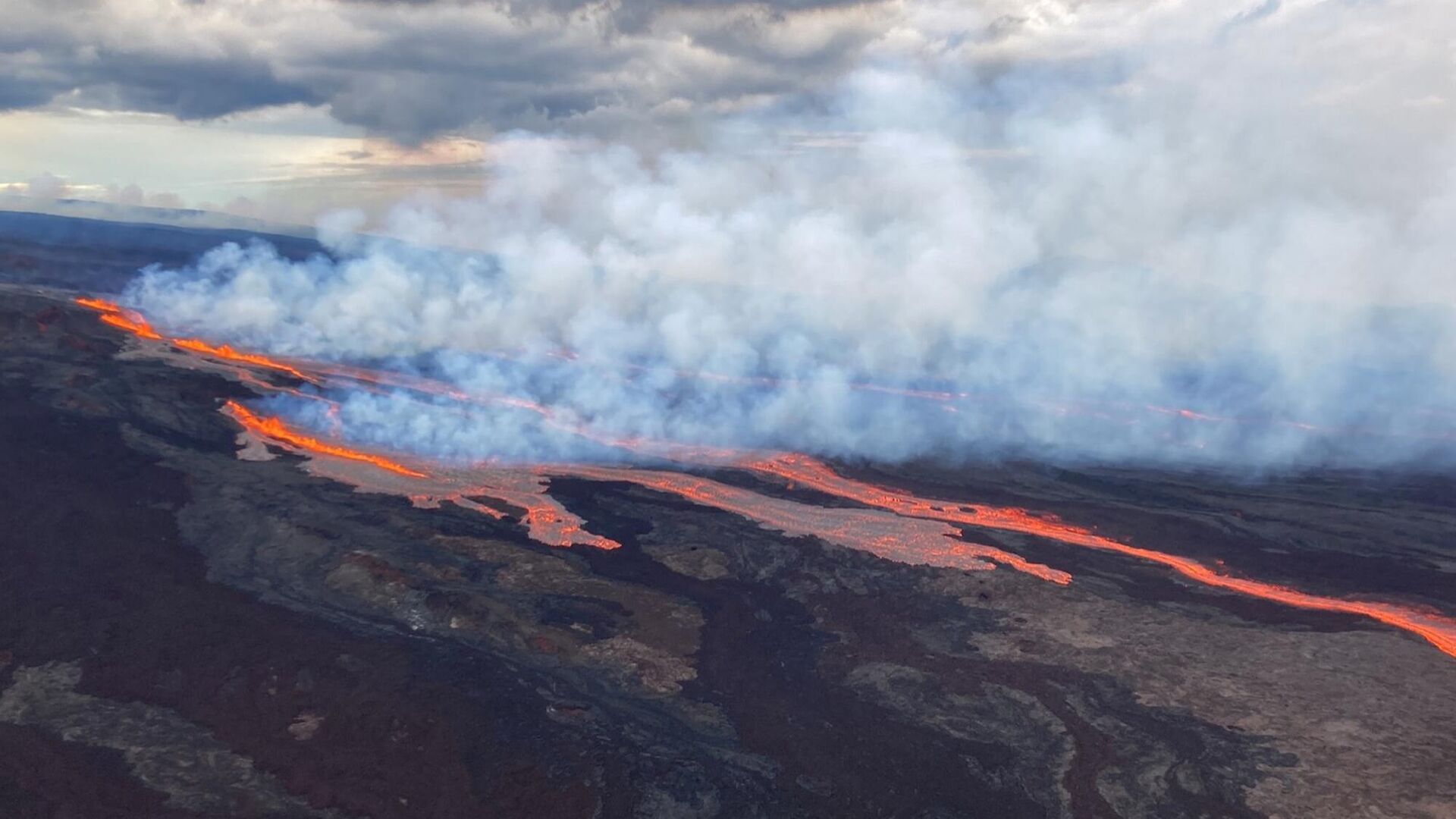https://sputnikglobe.com/20221202/lava-flow-in-hawaii-threatens-health-of-residents--islands-main-highway-1104951873.html
Lava Flow in Hawaii Threatens Health of Residents & Island’s Main Highway
Lava Flow in Hawaii Threatens Health of Residents & Island’s Main Highway
Sputnik International
Mauna Loa is the world’s largest active volcano and makes up 51% of the Hawai’i Island and stands 13,681 feet above sea level and 30,000 feet from the bottom... 02.12.2022, Sputnik International
2022-12-02T03:40+0000
2022-12-02T03:40+0000
2022-12-02T03:37+0000
americas
volcano
volcano eruption
volcano eruption
hawaii
us geological survey’s hawaiian volcano observatory
hawai'i volcanoes national park
https://cdn1.img.sputnikglobe.com/img/07e6/0b/1c/1104801242_0:103:2000:1228_1920x0_80_0_0_d81c00ed64f8f5f963a5f4b0fde02374.jpg
On Sunday at around 11:30 p.m., the Mauna Loa volcano erupted for the first time in 38 years. Lava which shot up in fountains that measured 148 feet in height has been crawling towards the Daniel K. Inouye Highway, and was reported to be just 3.6 miles away from the island’s fastest route on Thursday morning. The United States Geological Survey (USGS) said it would take a minimum of two days for the lava to reach the road.The highway is a major route that runs through the saddle region between Mauna Loa and Maunakea, and allows thousands of people to travel each day between the east and west sides of Hawai’i.“Of course, [Daniel K. Inouye Highway] is a very important state highway,” said Talmadge Magno, the Hawai‘i County Civil Defense administrator, during a Wednesday conference. Magno added that any interruption to that highway would force residents to use Highways 11 and 19 and would most likely result in an increase traffic. Currently, the Hawai’i Department of Transportation is monitoring the lava’s impact and will need to provide commuters with a six-hour notice before shutting down the highway if the lava impedes the bypass.Officials added that because the lava is flowing at a slow rate, the fastest that it could reach the highway would be on Friday.“We expect it will probably take longer than that,” said Ken Hon, the Hawaiian Volcano Observatory scientist-in-charge. “As the lava flow spreads out, it will probably interfere with its own progress and we expect it to slow down some from that previous rate. So we’re looking at about two days out at the earliest that it might actually hit the Saddle Road at this point.”The USGS reported on Thursday that it could even take up to a week before the lava reaches the highway, based on an estimate conducted by their researchers.Another volcano, one which is just 21 miles from Mauna Loa, is erupting in Hawai’i; however, the Kilauea volcano has been erupting since last year. Since Kilauea's activity is now coinciding with Mauna Loa, state officials are warning of possible health issues such as volcanic smog which includes “ash in the air, and levels of sulfur dioxide to increase and fluctuate in various areas of the state,” according to the state's health department.“You’re talking hydrogen fluoride, hydrogen sulfide, carbon dioxide. These are all gasses that are really not fun for average folks to breathe in, let alone if you have any sort of respiratory issue,” said volcanologist Jess Phoenix.Despite the dangerous air conditions, Governor David Ige told reporters on Wednesday that it is safe to visit the island, but he has wanted visitors and residents to not stop on the highway if they wish to sightsee the volcanic lava as it could cause accidents.
americas
hawaii
Sputnik International
feedback@sputniknews.com
+74956456601
MIA „Rosiya Segodnya“
2022
Mary Manley
https://cdn1.img.sputnikglobe.com/img/07e6/01/0b/1092187887_0:0:2048:2049_100x100_80_0_0_0c2cc4c84f89aff034cc55bb01fb6697.jpg
Mary Manley
https://cdn1.img.sputnikglobe.com/img/07e6/01/0b/1092187887_0:0:2048:2049_100x100_80_0_0_0c2cc4c84f89aff034cc55bb01fb6697.jpg
News
en_EN
Sputnik International
feedback@sputniknews.com
+74956456601
MIA „Rosiya Segodnya“
Sputnik International
feedback@sputniknews.com
+74956456601
MIA „Rosiya Segodnya“
Mary Manley
https://cdn1.img.sputnikglobe.com/img/07e6/01/0b/1092187887_0:0:2048:2049_100x100_80_0_0_0c2cc4c84f89aff034cc55bb01fb6697.jpg
volcano, volcano eruption, volcano eruption, hawaii, us geological survey’s hawaiian volcano observatory, hawai'i volcanoes national park
volcano, volcano eruption, volcano eruption, hawaii, us geological survey’s hawaiian volcano observatory, hawai'i volcanoes national park
Lava Flow in Hawaii Threatens Health of Residents & Island’s Main Highway
Mauna Loa is the world’s largest active volcano and makes up 51% of the Hawai’i Island and stands 13,681 feet above sea level and 30,000 feet from the bottom of the sea. According to the National Park Service, the volcano has erupted 34 times since 1843, and on Sunday the volcano erupted for the first time in 38 years.
On
Sunday at around 11:30 p.m., the Mauna Loa volcano erupted for the first time in 38 years. Lava which shot up in fountains that measured 148 feet in height has been crawling towards the Daniel K. Inouye Highway, and was reported to be just 3.6 miles away from the island’s fastest route on Thursday morning.
The United States Geological Survey (USGS) said it would take a minimum of two days for the lava to reach the road.The highway is a major route that runs through the saddle region between Mauna Loa and Maunakea, and allows thousands of people to travel each day between the east and west sides of Hawai’i.
“Of course, [Daniel K. Inouye Highway] is a very important state highway,” said Talmadge
Magno, the Hawai‘i County Civil Defense administrator, during a Wednesday conference. Magno added that any interruption to that highway would force residents to use Highways 11 and 19 and would most likely result in an increase traffic.
Currently, the Hawai’i Department of Transportation is monitoring the lava’s impact and will need to provide commuters with a six-hour notice before shutting down the highway if the lava impedes the bypass.
“It’s a hassle to drive all the way around the island,” said Emmanuel Carrasco
Escalante, a landscape worker, who told an American news outlet that he would have to change his commute if the highway shuts down. “If the road closes, that would add almost two hours, more gas, and more miles so hopefully it (lava) doesn’t cross that road.”
Officials added that because the lava is flowing at a slow rate, the fastest that it could reach the highway would be on Friday.
“We expect it will probably take longer than that,” said Ken Hon, the Hawaiian Volcano Observatory scientist-in-charge. “As the lava flow spreads out, it will probably interfere with its own progress and we expect it to slow down some from that previous rate. So we’re looking at about two days out at the earliest that it might actually hit the Saddle Road at this point.”
The USGS reported on Thursday that it could even take up to a week before the lava reaches the highway, based on an estimate conducted by their researchers.
“Note, we just got a revised estimate based upon the flow-front location measured by our team on the ground,” the USGS tweeted. “Because of the spreading flow front and flat topography, it could be a week before it intersects the road."
Another volcano, one which is just 21 miles from Mauna Loa, is erupting in Hawai’i; however, the Kilauea volcano has been erupting since last year. Since Kilauea's activity is now coinciding with Mauna Loa, state officials are warning of possible health issues such as volcanic smog which includes “ash in the air, and levels of sulfur dioxide to increase and fluctuate in various areas of the state,” according to the state's health department.
“You’re talking hydrogen fluoride, hydrogen sulfide, carbon dioxide. These are all gasses that are really not fun for average folks to breathe in, let alone if you have any sort of respiratory issue,” said volcanologist Jess Phoenix.
Despite the dangerous air conditions, Governor David Ige told reporters on
Wednesday that it is safe to visit the island, but he has wanted visitors and residents to not stop on the highway if they wish to sightsee the volcanic lava as it could cause accidents.
“The concern is about dangerous gasses from the fissures. And the most dangerous is sulfur dioxide,” Ige said Wednesday, who is issuing an Emergency Proclamation for the eruption. “Observing the volcano should occur at a distance. It’s not safe to get up close.”





